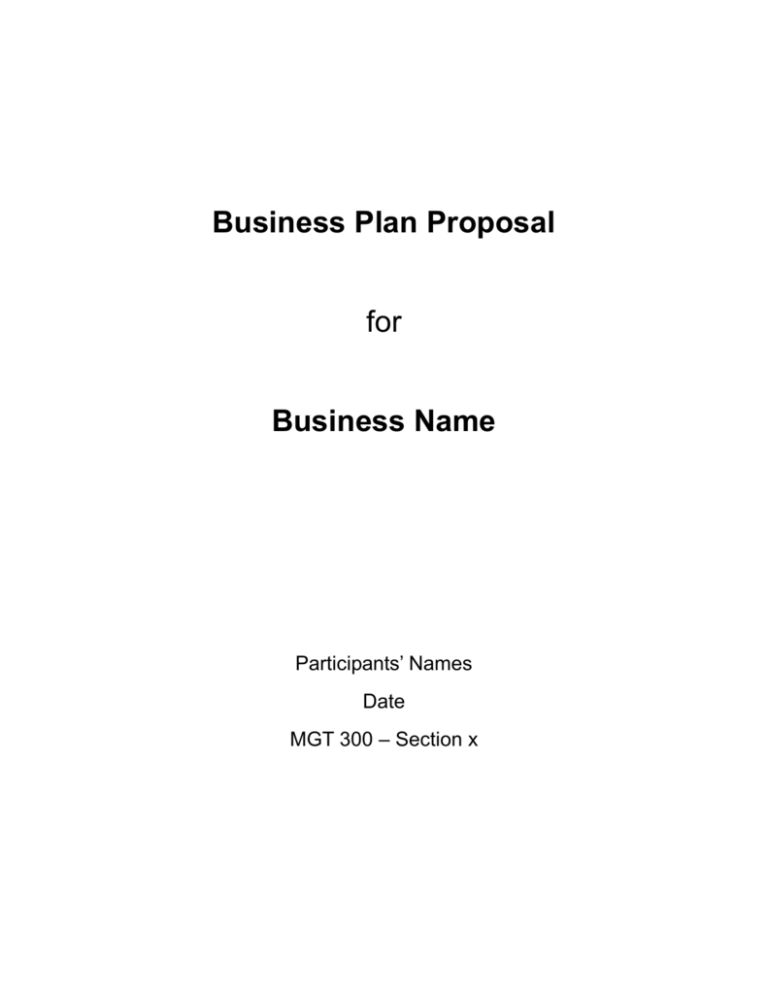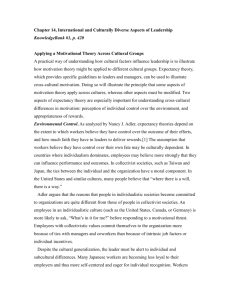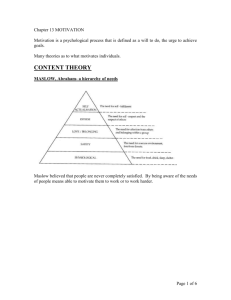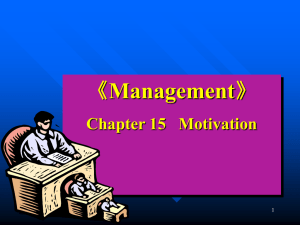Business Plan Template
advertisement

Business Plan Proposal for Business Name Participants’ Names Date MGT 300 – Section x Executive Summary One to two page executive summary. Overview Mission The mission is an organization’s fundamental purpose, articulated to define the nature of the business and unify human and other resources. A well-framed mission provides a sense of purpose and establishes parameters that focus effort and resources. It answers the questions why do we exist and what do we do? Who are we and where are we headed? To be useful a mission statement should: Articulate the vision that defines the business, what it is, what it is not, and what it should be in the future. Communicate to internal members and external constituencies a clear sense of meaning and direction that is motivating and energizing Convey which customer wants and needs it will seek to satisfy, and the target markets it will serve Identify the value-adding functions it will perform, realizing its specific enabling actions will change over time while the purpose endures. Be of bumper-sticker length – brief enough to be incorporated into corporate communications and easily remembered Key Stakeholders Stakeholders are members of identifiable clusters of people who have economic and/or social interests in the behaviors and performance of the organization. Who are the key stakeholders and how will their interests be managed and served by the firm? Vision A vision is a desired future image of the organization and its processes and products that integrates current realities and expected future conditions within a specific time frame. Three elements are fundamental to a comprehensive, meaningful vision: A statement of purpose – it should inspire and motivate insiders A tangible goal – framing a clear, specific and compelling goal that focuses people’s efforts. A well-framed goal has a target and a time frame for its attainment. An image of results – the image should paint a compelling picture using crisp language Culture and Values Organizational culture is the fundamental assumptions people share about an organization’s values, beliefs, norms, symbols, language, rituals, and myths – all the expressive elements that give meaning to organizational membership and are accepted as guides to behavior. Values are the enduring beliefs and expectations that a person or group hold to be important guides to behavior. The top five organizational values are: 1. 2. 3. 4. 5. Provide excellent service to customers. Operate in a highly ethical manner at all times. Provide products and/or services of excellent quality. Consistently make a fair and reasonable profit (not maximize profits). Staff the organization with high-caliber employees from top to bottom. Describe the type of culture and values you wish to have in the firm. How will you help to create and nurture that culture? Competition and Strategy Competitive Environment Description of the competitive environment of the company. Five Forces Analysis State of Industry Competition (Rivalry) Describe the state of industry competition. Threat of New Entrants (Barriers to Entry) Describe the threat of new entrants. Threat of Substitute Products Describe the threat of substitute products. Bargaining Power of Suppliers Describe the bargaining power of suppliers. Bargaining Power of Buyers Describe the bargaining power of buyers (customers). SWOT Analysis Strengths Internal strengths. Weaknesses Internal weaknesses. Opportunities External opportunities. Threats External threats. Competitive Strategy Competitive advantage occurs whenever a business is able to sustain an edge over its rivals by attracting customers and defending itself against competitive forces. To achieve a strategic competitive advantage, all enterprises build their strategies around a core of physical assets, business processes, and the skills and talents of its people. Core capabilities provide the keys to long-term success by enabling the firm to combine assets and skills to do certain things better than competitors. How will your firm achieve competitive advantage? Select your company’s approach to strategy: A low-cost leadership strategy – Appealing to a broad spectrum of customers based on being the overall low cost provider of a product or service. A broad differentiation strategy – Seeking to differentiate the company’s product offering from rivals’ in ways that will appeal to a broad spectrum of buyers. A best-cost provider strategy – Giving customers more value for the money by combining an emphasis on low cost with an emphasis on upscale differentiation; the target is to have the best (lowest) costs and prices relative to producers of products with comparable quality and features. A focused or market niche strategy based on lower cost – Concentrating on a narrow buyer segment and outcompeting rivals by serving niche members at a lower cost than rivals. A focused or market niche strategy based on differentiation – Concentrating on a narrow buyer segment and outcompeting rivals by offering niche members a customized product or service that meets their tastes and requirements better than rivals’ offering. Type of Competitive Advantage Being Pursued A Broad CrossSection of Buyers A Narrow Buyer Segment Market Target Lower Cost Differentiation Overall Low-Cost Broad Leadership Differentiation Strategy Strategy Best-Cost Provider Strategy Focused Focused LowDifferentiation Cost Strategy Strategy How does your firm’s strategy compare to your competitor’s strategies? Objectives / Balanced Scorecard Objectives convert visionary intentions into specific performance targets that can be measured at designated points in time. Benchmarking can be used to compare a unit’s performance to outcomes achieved in other outstanding organizations. A Balanced Scorecard is a management tool that encapsulates the strategy of the business and provides feedback on the success of the strategy in four perspectives: Financial, Customer, Internal Business Process, and Corporate Learning and Growth. Properly constructed, the Balanced Scorecard identifies and communicates the cause and effect relationships between the strategic objectives, the outcome measures (lagging indicators) and the performance drivers (leading indicators). It also makes clear the assumptions behind the strategy and the cause and effect relationships and enables the continual validation of these assumptions. A good benchmark is to keep it simple and have not more than 3-5 measures per perspective. Financial Objectives Example measures: sales growth rate, % revenue from new products, cross-selling, revenue/employee, indirect expenses % of sales, investment % of sales, R&D % of sales, return on investment, economic value added, profitability, revenue growth/mix, cost reduction. Customer Objectives Example measures: Product attributes (quality, price, time), company image and reputation, customer relationship, strategic relationships, market share, customer acquisition, customer retention, customer profitability, customer satisfaction. Business Process Objectives Example measures: Yields, cycle time, time to market, design modifications, break-even time, product development, sales from new products, operations (time, cost, quality), service (time, cost, quality). Learning & Growth (Employee) Objectives Example measures: Employee capabilities, employee suggestions, goals alignment, employee satisfaction, employee retention, employee productivity. Marketing Plan Your product should be derived from a market need. What market need do you see? Discuss the elements of your marketing mix to fill this need: Product Description of your product. Price What is your pricing strategy? Place Where will customers find your product? Promotion How will you promote your product? Organization How will you organize the firm? What organizational structure will you use? Keep in mind that your organizational structure should be in alignment with your stated mission, vision, culture, strategy and objectives. Keep in mind the fundamental trade-offs for balancing organizational design. Draw an organizational chart to depict the different organizational units in the firm. What span of control will your firm employ? Will you use self-managed teams? If so, does the span of control reflect this? What functions will the teams perform and what will the role of managers be? Will you use cross-functional teams? If so, when and for what? The basic organizational structures are: Design by Function – grouping people into departments or subunits based on similar skills, expertise, and functions performed – such as product design, production, and marketing. Advantages: Works best when a company has a single line of business and/or is relatively small. Ideally suited to encourage specialization and prompt people to keep up with the latest technical developments in their specialty field. If departmental tasks are relatively independent, a high level of functional efficiency is possible. Because of departmental specialization, the functional form relies on pushing decisions to a higher level of management for control and coordination, which may not be an efficient use of managerial time. Disadvantages: Extreme specialization creates tunnel vision. People tend to perceive multifunctional problems from the vantage point of their narrow area of expertise. This leads to conflict and turf protecting, which can strain the process of communication and coordination in the absence of a decisive leader. Decisions that are complex, or span two or more functions tend to get pushed to the top for resolution, slowing decision responsiveness as the organization becomes larger and more layered. Maintaining quality becomes difficult, since few people genuinely feel responsible for customer satisfaction or the acceptance of decisions. A functional design also complicates the process of developing broad-based general managerial skills, because functional managers have a limited range of specialized experiences. Design by Geography – with organizational growth, this design creates units focused on serving the needs of a region or territory, which could include organizing by country or hemisphere. Advantages: Emphasizes local adaptation to market and/or supplier conditions. Especially well suited to retain chains, the U.S. Postal Service, public accounting partnerships, urban police departments, and fast-food restaurants. For organizations engaged in customer service, a regional structure allows local personnel and managers to be responsive to pressures and opportunities in their region. It promotes competitiveness and quality. Geographic design also makes it possible to create many profit centers where local general managers are responsible for both revenues and expenses. Disadvantages: Maintaining consistency of image and service can be compromised by a geographic design. The dilemma faced by headquarters managers is how much freedom to allow local managers versus how much control to exercise centrally. This decision typically depends on the size and complexity of the territory to be managed locally. A multi-national firm will grant greater autonomy to its business unit managers in foreign countries than national (or regional) firms within a single region. Design by Product Line – A structural grouping on the basis of the unique product or service each activity center provides. Advantages: Promotes entrepreneurial behavior. Product-line executives typically have profit center responsibility to reinforce accountability. Disadvantages: The difficulty of coordinating related activities across business units. Rivalry is likely to exist – rivalry not only for customers for also for corporate resources. If several business units separately draw on similar core technologies for the research and design of products, they likely forgo economy of scale savings and may be slow to share with other units the technological breakthroughs discovered in one unit. Some duplication of function specialization is almost inevitable. Design by Customer/Market Channel – Clustering human talent and resources so that each organizational unit focuses on the unique sales/service requirements for each type of customer or channel of distribution – such as the home market, commercial accounts, or resellers. Advantages: Usually used in combination with one or more other designs. They serve well the needs of the business when product lines can be marketed to very distinct customer segments. Their advantage is that special customer needs can focus quality service throughout each organizational unit. To create high employee involvement, Edward Lawler believes that customer-based design is optimum. Focusing on the customer enables the competitive market – not hierarchical controls or supervisor whims – to affirm or modify employee behavior. Disadvantages: The challenge for companies offering several lines of products to the same customer is to balance product expertise (a benefit of product-focused designs) with the simplicity of having one voice speak to the customer. Market focused designs also tends to require duplication of sales and marketing staff, with two or more groups selling the same product line. Human Resources Staffing How will you staff the firm? Where will employees come from? What is the current labor market for the types of employees you will need? Will you use personality tests? If so, for what purpose? Motivation Motivational Models How will you motivate the employees? Which motivational models will you employ and which employee needs will you attempt to satisfy and focus on to obtain motivation? How will you satisfy those needs? Is this approach in alignment with the rest of your plan? Maslow’s Hierarchy of Needs - a five-level need theory proposed by Maslow in which lower-level basic needs must be satisfied before advancing to a higher-level need. Once a lower-level need has been largely satisfied, its impact on behavior diminishes and a person can activate the next higher-level need. o Self-actualization needs – the peak of human existence – the ability to develop latent capabilities and realize fullest potential. o Esteem needs – Psychological well-being, built on the perception of oneself as worthy and recognized by others. o Love or belonging needs – Beyond existence needs lies the desire for nurturing, acceptance, respect, and caring relationships. o Safety needs – Need to be free from harm or danger, to have a secure and predictable life. o Physical needs – Most basic is the need for relief from thirst, hunger, and physical drives. ERG Theory – Alderfer’s simplified content theory that identifies existence, relatedness, and growth as need categories, and acknowledges multiple needs may be operating at one time without being hierarchically determined. Herzberg’s Dual-Factor Theory – job satisfaction and job dissatisfaction derive from different sources and simply removing the sources of dissatisfaction will not cause a person to be motivated to produce better results. The theory is based on two independent needs: hygiene and motivator factors. o Hygiene factors are job context factors such as working conditions and benefits that trigger dissatisfaction if inadequate. Such factors are largely extrinsic, or external to the nature of the job itself; thus they can be thought of as job context factors. If adequate, they simply produce neutral feelings with the realization that basic maintenance needs are taken care of. o Motivator factors are job content factors such as job challenge, responsibility, opportunity for advancement, achievement and recognition that which originate from the nature of the job itself and that provide feelings of satisfaction when experienced. Such factors are intrinsic to the job or unique to each individual. Theory X and Theory Y – From which assumption about people is your firm designed? Your choice may be affected by the types of employees you expect to have. o Theory X assumptions about human behavior postulates that people act only to realize their basic needs and therefore do not voluntarily contribute to organizational aims. Managers believe their task is to direct and modify human behavior to fit the needs of the organization. Managers must persuade, reward, punish, and control those who don’t naturally strive to learn and grow. o Theory Y views of human behavior sees people motivated by higher-order growth needs and they will therefore act responsibly to accomplish organizational objectives. Management’s task is to enable people to act on these needs and to grow in their jobs; To structure the work environment so that people can best achieve their higher-order personal goals by accomplishing organizational objectives. Expectancy theory is a theory of motivation based on a person’s beliefs about effortperformance-outcome relationships. The three variables of expectancy theory: o Expectancy - The probability (from 0 to 1) that an individual believes his or her work effort directly affects the performance outcome of a task. Does how hard I try really affect my performance? To be motivated, you must have a positive answer to this expectancy question. Positive task motivation begins when you see a link between personal effort and task performance. o Instrumentality - The probability (from 0 to 1) that an individual anticipates that an attained level of task performance will have personal consequences. Are personal consequences linked to my performance? To answer this instrumentality question, you must believe that task performance results (a first order outcome) serve to obtain second-order personal consequences or payoffs. Increased motivation is possible when you perceive a positive personal consequence arising from satisfactory task performance. o Valence - The value (from positive to negative) that a person assigns to the personal consequences that follow work performance. Do I value the consequences available to me? Answers to this valence question depend on how much you value a particular expected personal outcome or payoff. A person must value the payoff if the expectancy loop is to be positive and motivational. Job Design What types of jobs will perform the main function of the firm? How will these jobs be structed in scope and depth? Task scope is the degree of task variety built into a job, typically called horizontal job loading when jobs are formally designed. A job narrow in scope has few activities. Task depth addresses how much vertical responsibility, individual accountability, and autonomous decision authority is expected in a job, often thought of as vertical job loading when formally designed. Task Depth (responsibility) Vertical Job Loading High Technician – offers greater opportunities for Enriched – enable an individual to feel independent thinking and deciding what to do when, but provide employees with little variety in their daily tasks. The technician may have a university education or need professional training to learn how to perform the job. The work may be valued by the client, bur research suggests that people find their jobs become meaningless over time because their job tasks are repetitive and there is little growth opportunity. Routine – Programmed to be repetitive and narrow in scope and are often restricted by technology. People in these simplistic and repetitive jobs are expected not to do much independent thinking, just pay attention to detail. Skills are mastered in a matter of hours or days; there is no expectation of career growth unless one becomes a supervisor over those performing these routine jobs. responsible for whole tasks. Most professional jobs that require analysis and manipulation of symbolic data are enriched to give the individual responsibility for doing whatever is necessary to get the job done. The work presents challenges and novelty, with the incumbent empowered to solve problems and find innovative solutions to shifting performance demands. Low Enlarged – Provides an expanded variety or diversity of tasks. At times jobs are deliberately expanded, either by adding on sequential tasks or by allowing employees to rotate among different jobs. Decreasing the number of separate job classifications or titles in a traditional industry typically affords employees enlarged variety or a change of pace. Task Scope (variety) Horizontal Job Loading High Empowerment – will you utilize some sort of empowerment? If so, what, and with who? How will this affect their jobs? Reward Systems What type of reward system will you utilize? Pay for Performance – Uniform systems of pay may seem equitable. But from a motivational perspective, such nonperformance payments do not necessarily encourage stellar performance. Now, the norm for systems of rewards incorporate more pay-forperformance factors. Performance-based compensation schemes are consistent with the expectancy theory of motivation. Employees compare rewards received for performance with what they expect to receive. They also compare what they receive with what others receive (equity factor). Overall satisfaction is likely a composite of how the employee perceives both the extrinsic and intrinsic rewards from the job. Piecework – the classic performance-based reward system, which is the practice of rewarding performance by paying for the amount produced consistent with quality standards. The difficulties are twofold: One is evaluating work methods to arrive at an equitable standard and rate. The second concern is the quality-quantity trade-off. Merit Pay (Base Plus Merit) – Rather than tie pay only to output, an alternative is to provide a base salary or hourly wage and then an incentive or bonus based on output. The performance-based portion depends on some measurable level of output over which the employee has control (quantity, quality, cost savings). Bonus and Profit-Sharing Plans – Compensation plans that are based on the overall performance of the enterprise rather than the individual’s contribution. A pool of money is divided among eligible employees based on some performance evaluation or rating system. The objective of merit plans such as profit sharing, bonuses, and stock options is to link everyone’s fate to overall performance, reinforcing corporate cultures that emphasize group results over individual performance. Gainsharing Plans – A pay-for-performance system that shares financial rewards among all employees based on performance improvements for the entire business unit. Rewards as a Cafeteria of Benefits – Allowing people to select from a portfolio or menu of benefits. Consequences of Incentives and Rewards – Except in cases where performance can be easily measured, employees often believe that the person evaluating them relies too much on subjective judgment (they question the fairness of the plan). While goals, incentives, and rewards can energize and focus behavior in some countries, there are potential pitfalls in using them as motivational systems: Quality may be traded off for quantity and vice versa. Communication What formal communication channels will you employ to facilitate communication upwards, downwards, and horizontally? Do you plan on using any concepts of Open Book Management? If so, how? What will you share? Financial Plan Discuss how much capital will be required to start up the business. Describe your source of start up capital. What are your estimated five-year revenues, expenses and profits? (no detail needed). When will you break-even?








